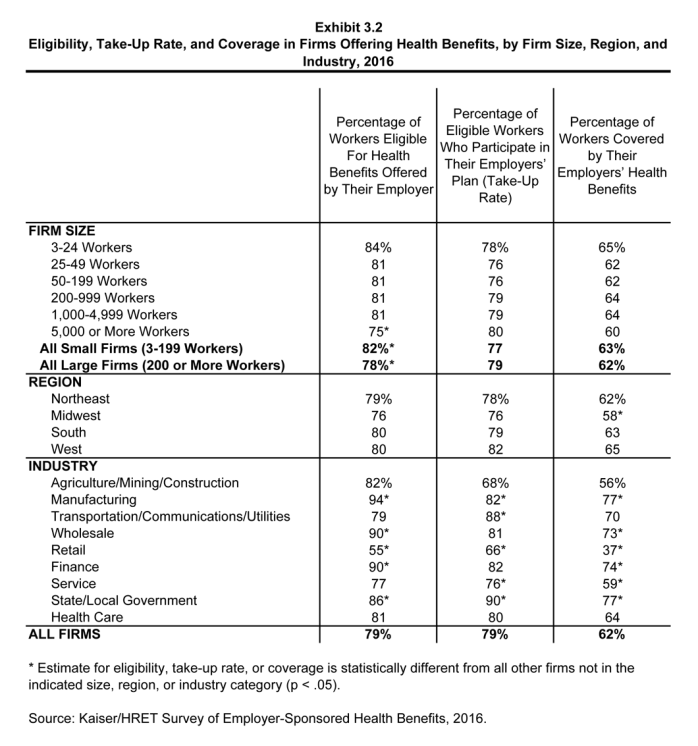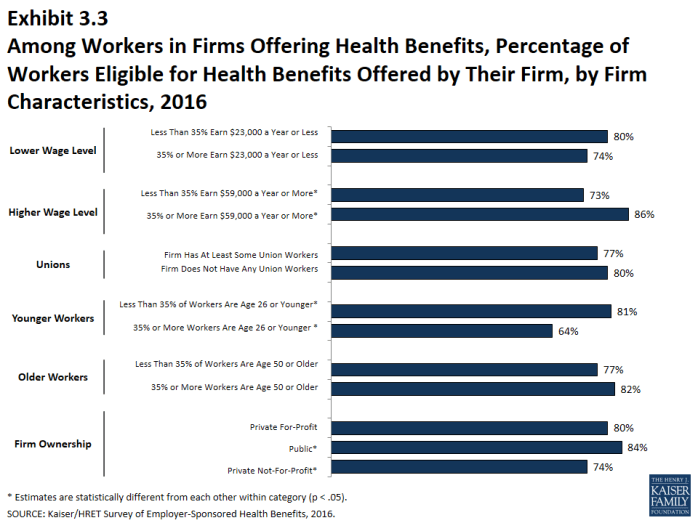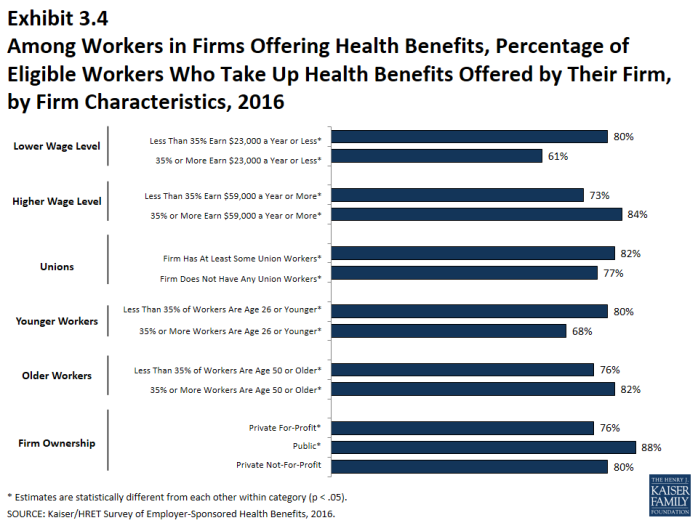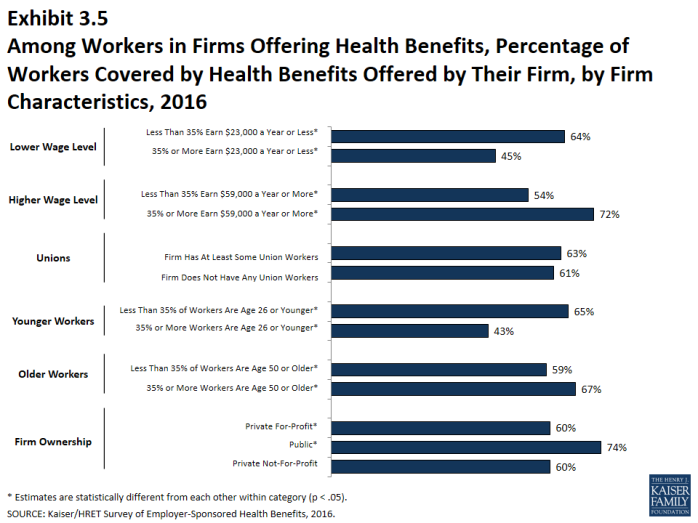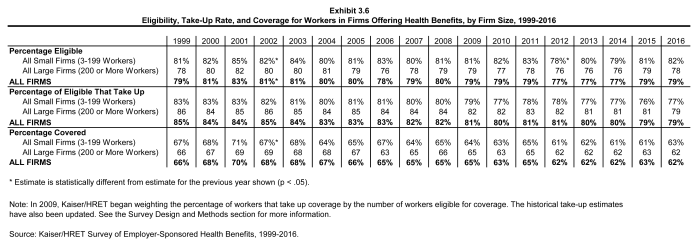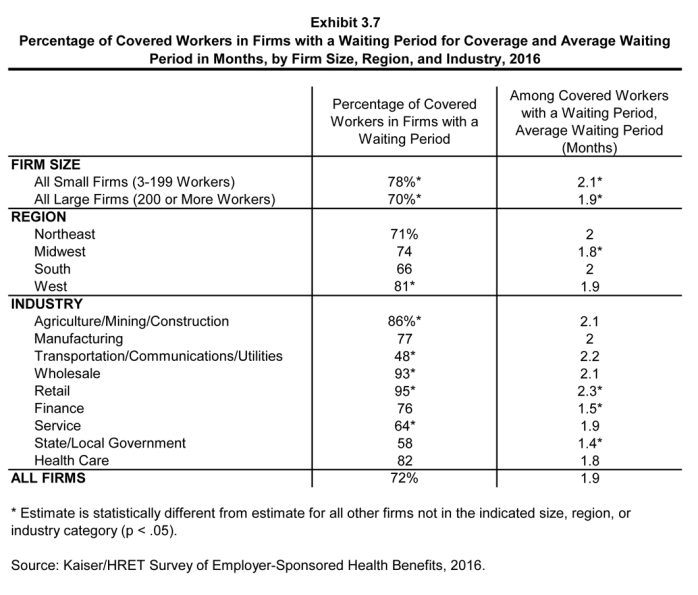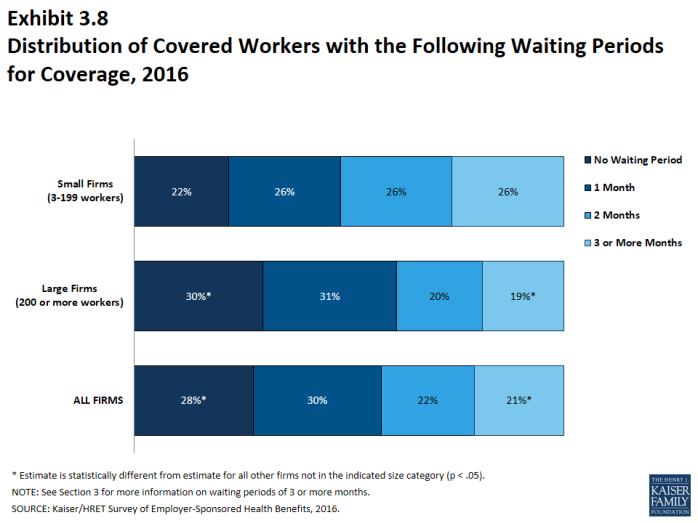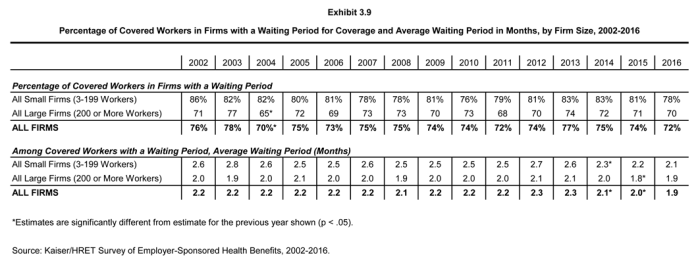2016 Employer Health Benefits Survey
Section Three: Employee Coverage, Eligibility, and Participation
Employers are the principal source of health insurance in the United States, providing health benefits for about 150 million non-elderly people in America.1 Most workers are offered health coverage at work, and the majority of workers who are offered coverage take it. Workers may not be covered by their own employer for several reasons: their employer may not offer coverage, they may be ineligible for the benefits offered by their firm, they may elect to receive coverage through their spouse’s employer, or they may refuse coverage from their firm. Before eligible employees may enroll, almost three-quarters (72%) of covered workers face a waiting period, although the average length waiting periods for covered workers with waiting periods has decreased since 2014 when an ACA provision prescribing a maximum waiting period of 90 days was implemented.
- Among workers at firms offering health benefits, 62% percent of workers are covered by health benefits through their own employer (Exhibit 3.2).
- Among workers in all firms, including those that offer and those that do not offer health benefits, 55% of workers are covered by health benefits offered by their employer, similar to the percentage (56%) last year. The coverage rate in 2016 is lower than the coverage rate in 2006 (59%) and in 2011 (58%) (Exhibit 3.1).
Eligibility
- Not all employees are eligible for the health benefits offered by their firm, and not all eligible employees “take up” (i.e., elect to participate in) the offer of coverage. The share of workers covered in a firm is a product of both the percentage of workers who are eligible for the firm’s health insurance and the percentage that choose to take up the benefit. The percentage of workers eligible for health benefits at offering firms in 2016 is similar to last year for both small firms and large firms (Exhibit 3.6).
- Seventy-nine percent of workers in firms offering health benefits are eligible for the coverage offered by their employer. The percentage of eligible workers is higher is small firms than in large firms (82% vs. 78%) (Exhibit 3.2).
- Eligibility varies considerably by wage level. Employees in firms with a larger share of higher-wage workers (35% or more earn $59,000 or more annually) are more likely to be eligible for health benefits than employees in firms with a smaller share of higher-wage workers (86% vs. 73%) (Exhibit 3.3).
- Eligibility also varies by the age of the workforce. Those in firms with a smaller share of younger workers (less than 35% of workers are age 26 or younger) are more likely to be eligible for health benefits than those in firms with a larger share of younger workers (81% vs. 64%) (Exhibit 3.3).
- The average eligibility rate is particularly low (55%) in retail firms (Exhibit 3.2).
Take-up Rate
- Employees who are offered health benefits generally elect to take up the coverage. In 2016, 79% of eligible workers take up coverage when it is offered to them, unchanged from last year (Exhibit 3.6).2
- The likelihood of a worker accepting a firm’s offer of coverage also varies with the workforce’s wage level. Eligible employees in firms with a smaller share of lower-wage workers are more likely to take up coverage than eligible employees in firms with a larger share of lower-wage workers (35% or more of workers earn $23,000 or less annually) (80% vs. 61%). A similar pattern exists in firms with a larger share of higher-wage workers, with workers in these firms being more likely to take up coverage than those in firms with a smaller share of higher-wage workers (84% vs. 73%) (Exhibit 3.4).
- The percentage of eligible workers taking up benefits in offering firms varies considerably by industry (Exhibit 3.2).
Coverage
- The percentage of workers at firms offering health benefits that are covered by their firm’s health plan in 2016 is 62%. The coverage rate at firms offering health benefits is similar to last year for both small firms and large firms (Exhibit 3.6).
- There is significant variation by industry in the coverage rate among workers in firms offering health benefits. For example, only 37% of workers in retail firms offering health benefits are covered by the health benefits offered by their firm, compared to 77% of workers in manufacturing, and 77% of workers in the state/local government industry category (Exhibit 3.2).
- Among workers in firms offering health benefits, those in firms with a smaller share of lower-wage workers (less than 35% of workers earn $23,000 or less annually) are more likely to be covered by their own firm than workers in firms with a larger share of lower-wage workers (64% vs. 45%). A comparable pattern exists in firms with a larger share of higher-wage workers (35% or more earn $59,000 or more annually), with workers in these firms more likely to be covered by their employer’s health benefits than those in firms with a smaller share of higher-wage workers (72% vs. 54%) (Exhibit 3.5).
- Among workers in firms offering health benefits, those in firms with a smaller share of younger workers (less than 35% of workers are age 26 or younger) are more likely to be covered by their own firm than those in firms with a larger share of younger workers (65% vs. 43%) (Exhibit 3.5).
- Among workers in all firms, including those that offer and those that do not offer health benefits, 55% of workers are covered by health benefits offered by their employer, similar to the percentage (56%) last year. The coverage rate in 2016 is lower than the coverage rate in 2006 (59%) and in 2011 (58%),
Waiting Periods
- Waiting periods are a specified length of time after beginning employment before employees are eligible to enroll in health benefits. With some exceptions, the Affordable Care Act requires that waiting periods cannot exceed 90 days.3 For example, employers are permitted to have orientation periods before the waiting period begins which, in effect, means an employee is not eligible for coverage 3 months after hire. If an employee is eligible to enroll on the 1st of the month after three months of employment, this survey rounds up and considers the firm’s waiting period four months. For these reasons, some employers still have waiting periods exceeding the 90-day maximum.
- Seventy-two percent of covered workers face a waiting period before coverage is available, similar to last year (Exhibit 3.9). Covered workers in small firms (3-199 workers) are more likely than those in large firms to have a waiting period (78% vs. 70%) (Exhibit 3.7).
- The average waiting period among covered workers who face a waiting period is 1.9 months (Exhibit 3.7). A small percentage (3%) of covered workers with a waiting period have a waiting period of more than 3 months.
- Among firms with a waiting period of greater than 4 months, a majority of firms indicated that they have an employee measurement period. 4


